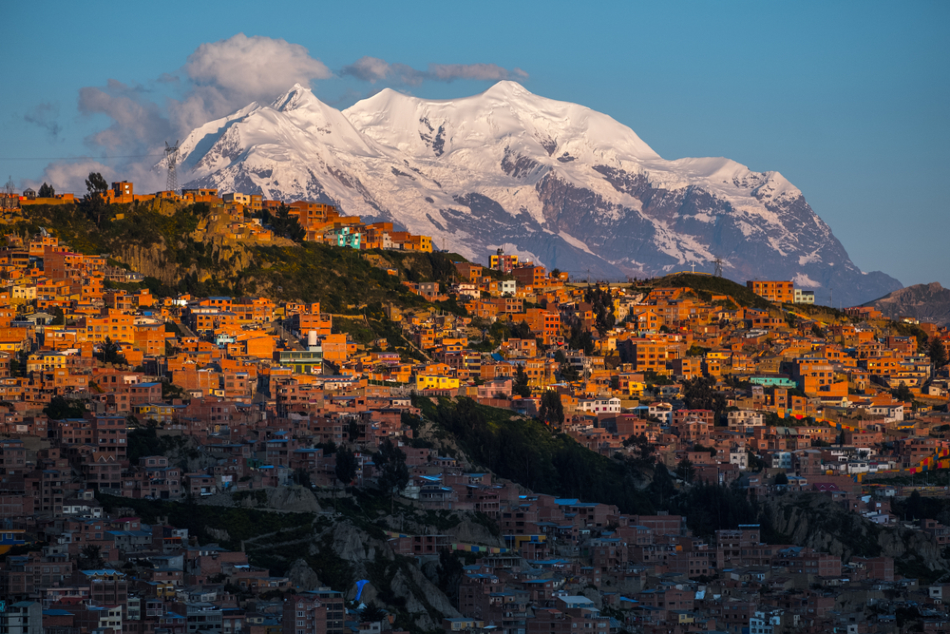
Image Credit: Dudarev Mikhail/Shutterstock.com
Article updated on 26/02/20 by Reginald Davey
Bolivia is located in Central South America to the southwest of Brazil. It is the 28th largest country in the world with an area of 1,098,581 km2. As per 2018 estimates, it has a total population of 11,306,341. The climatic conditions of the country vary from humid and tropical to cold and semiarid.
.gif)
The national flag of Bolivia. Image Credit: CIA factbook
Bolivia has a lot of untapped natural resources and supplies its mineral resources to the global market in raw forms such as concentrates and ores. According to 2017 reports, mineral product exports were worth $4.94bn and the country’s GDP in 2017 was $83.72bn.
The Bolivian economy is greatly affected by the lack of foreign investment in the mining and hydrocarbon sectors, though recent laws passed by the government have tried to help this mountainous nation turn a corner. Recent political unrest in the country is being monitored closely by international observers and may prove to be problematic for the mining and petroleum industries.
Overview of Resources
Bolivia is rich in resources such as petroleum, natural gas, gold, silver, tungsten, zinc, lead, and tin. In addition, the country has considerable resources of potash, platinum, tantalum, palladium, iron ore, nickel, indium, and cadmium.
As per 2010 estimates, the country has produced nearly 8% of the world’s total tin output, 6% of silver, 4% of antimony, 3% of boron and zinc each, 1% of bismuth, and 2% each of lead and tungsten. It is one of the top three producers of natural gas in South America. Nearly 80% of the natural gas produced in the country is exported.
Industrial Minerals and Gemstones
Bolivia has many undeveloped potassium and lithium resources. The country is rich in mineral resources including silver, tin, iron ore, antimony and indium.
.gif)
The Map of Bolivia. Image Credit: CIA factbook
Furthermore, the country has significant amounts of gemstones ametrine (which is the national gem of Bolivia) amethyst, and citrine available in the Anahi mine, which is located in the La Gaiba mining district in Sandoval Province. Bolivia is responsible for nearly all the commercially available ametrine which is mined in the world.
Metals
The main metals mined in Bolivia include tin, silver, and iron ore. Recently, there have been issues with production from several mines due to ore depletion and ore theft, which has had a significant impact on output.
In 2018, Bolivia produced 6,200 tonnes of tin at the Huanuni tin mine, which is the lowest output from the mine for a decade. It is hoped that the new tin processing plant at Lucianita, which will replace the aging Santa Elena processing plant, will help to overcome the problems with production. This project has been delayed for several years, but with the construction of a new $16m tailings dam, it is hoped that this will change.
The San Bartolome silver mine, which is the largest known single concentration of silver in the world, produced 5.436,353 oz of silver in 2015, which was the last year records are available for the mine. This was obtained from 1,713,079 tons. In 2016 1,66,787 tons of ore were milled. According to figures from December 2017, there were 1,640,000 proven tons of silver, with a total of 1.8 million proven and probable tons.
Fossil Fuels
Bolivia is rich in crude petroleum and natural gas resources. The government is investing heavily in the country’s hydrocarbons industry.
In 2019, YBFP, the Bolivian state-owned hydrocarbons company, announced that it would be investing $1.45bn in the natural gas sector, including $450m on exploration efforts. Roughly $20m of the exploration budget was earmarked for the digging of the Florida-X2D exploratory well. Luis Alberto Sanchez, Bolivia’s hydrocarbons minister, announced plans to double the country’s natural gas reserves of 10.7 trillion cf by 2025.
Also in 2019, Spain’s Reposol’s drilling efforts at the Boyuy-X2 well in Bolivia achieved a depth of 7.963 m, which is the deepest onshore well in South America. Reposol has invested more than $100m on the project.
Important discoveries are expected at the Huacareta block by Shell and the Azero block by a Total-Gazprom joint venture. Vintage Petroleum has announced a gas discovery at the Chaco Este-X1 well which has production estimates of 20 mn m3/day.
Investment
Due to the recent political crises and ongoing economic instability in this hydrocarbon and mineral-rich nation, foreign investment has understandably wavered.
Recent events suggest the need for the Bolivian government to bring in some serious structural and political changes that will help stabilize its ailing mining industry. Moreover, the country needs to focus on investing more in the mining sector to increase boron production and expand lithium production capacity. It also needs to take more initiative to outline investor-friendly policies in the future.
However, the Bolivian government is looking to court international investment in its ailing mining industry by expanding a portfolio of base and precious metal projects worth $4.3bn. They are working on changing Bolivia’s mining law and developing a mining incentive law. It is hoped that, with further investment, cooperation, and stabilization of the political situation, Bolivia’s mining industry will be able to turn a corner.
Disclaimer: The Author of this article does not imply any investment recommendation and some content is speculative in nature. The Author is not affiliated in any way with any companies mentioned and all statistical information is publically available.
References and Further Reading